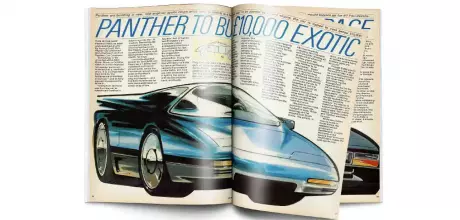40 Years Ago Today Did Toyota scupper Panther’s plans for a British sports car revolution?
Amid the hot hatch revolution, Panther planned a groundbreaking sports car. Littledid it or its low-volume British rivals know, Toyota had the same idea.
Many people admire Ferrari and Lotus but most can’t afford them,’ said Panther’s South Korean boss Young Chull Kim in an interview in CAR’s March 1984 issue. ‘It’ll be different with EM25.’
The EM25 was a plan for something genuinely revolutionary. In a motoring landscape where the small sports car had been all-but wiped out by the hot hatch, and yet at the same time outlandish supercars hogged headlines and screen time alike, Kim rightly noted a niche ripe for exploitation.
It wasn’t just speculation either. Kim actually had a plan in place. The mid-engined Panther EM25 would be powered by a 1.6-litre fuel-injected Ford CVH engine from the Escort XR3i. A smart choice to maximise sales because the powerplant was federalised for use in the US. ‘Escort parts are for sale and approved on either side of the Atlantic,’ too, he pointed out. Len Bailey – who designed the Ford GT40’s chassis and was currently plying his trade in Group C with the Ford C100 and EMKA-Aston Martins – had been signed up to devise the underpinnings.
The styling sketch was the work of John Heffernan and Ken Greenley, RCA design scions later known for conjuring up the Aston Martin Virage and Bentley Continental R. ‘We plan to use mass-production methods,’ Kim continued. ‘Body pressings will be shipped from South Korea. The panels, in alloy, are to be pressed at Inchan.’ But assembly would be at Panther’s new factory at Brooklands, where Kallistas were being built. ‘Britain makes the best sports cars,’ Kim stressed, but the ultimate aim was to create a new kind of affordable British sports car that could capture the American market the way Austin-Healey, MG and Triumph had done in the Fifties. How affordable? ‘It could be below £10,000.’
This slotted it between the Toyota Celica and Supra. Unfortunately for Panther, Toyota released the MR2, ostensibly doing everything Kim had promised of the EM25 for £9295. In the US, Pontiac did the same with the Fiero. Both could build cars much faster than Panther’s projected 25 weekly EM25s out of Brooklands. By the time an EM25 prototype – now named the Solo – was built, the MR2 rendered it void.
Kim didn’t give up though. By 1989, the Solo had been reworked into a composite-monocoque four-wheel-drive turbocharged supercar of the kind Kim bemoaned as unaffordable. Fewer than 25 were made, 11 survive, and at £40k it cost Maserati Biturbo Spyder money. In the meantime, Toyota sold 166,104 MR2s. Intriguingly, also by 1989, fellow British compatriot Ginetta followed Panther’s original EM25 plan with its CVH-powered, £10,995 mid-engined G32. It sold a grand total of 115. Its biggest problem? The Toyota MR2.


